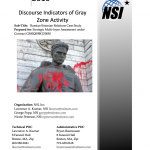Discourse Indicators of Gray Zone: Estonia
January 2017 No Comments
Discourse Indicators of Gray Zone Activity: Russian-Estonian Relations Case Study.
Author | Editor: Dr. Lawrence Kuznar, George Popp, & Nicole (Peterson) Omundson (NSI, Inc.)
The increasing use of emotive themes and rhetorical devices (that amplify a message’s emotional effect) provide indicators of gray zone activities in speeches made by Eurasian regional leaders and has the potential to provide leading indicators and reveal key issues and concerns.
Indicators & Warnings (I&W)
- Putin exhibits a sustained concern over Europe and the threat of Nazism, consistent with earlier studies (Kuznar, 2016b).
- The overall sentiment between the Putin and Estonian governments demonstrates increasingly negative relations between the two countries.
Predominant Concerns of Regional Actors
- The Putin government predictably stresses the plight of Russian Minorities in Estonia, and the need for Cooperation in its discourses on Estonia.
- Ethnic Russian-Estonians emphasizes their ethnic Identity.
- The Estonian government stresses the need for Cooperation.
Use of Emotional Language
- The Estonian government used nearly five times the amount of emotional language (emotional themes and rhetorical devices) used by the Putin government.
- This pattern reflects other studies that have demonstrated that the Putin government generally uses much more restrained language than other leaders (Kuznar, Popp, & Peterson, 2017; Kuznar & Yager, 2016).
- This restrained language may be an indicator that the Putin government is more vulnerable to traditional deterrence operations (USSTRATCOM, 2006), provided that their values are accurately identified.

Comments